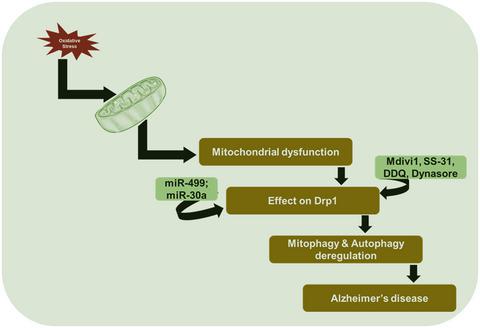当前位置:
X-MOL 学术
›
J. Neurosci. Res.
›
论文详情
Our official English website, www.x-mol.net, welcomes your
feedback! (Note: you will need to create a separate account there.)
Mitochondrial dysfunction, mitophagy, and role of dynamin‐related protein 1 in Alzheimer's disease
Journal of Neuroscience Research ( IF 2.9 ) Pub Date : 2021-01-19 , DOI: 10.1002/jnr.24781 Vijay Krishna Medala 1 , Buchaiah Gollapelli 2 , Saikat Dewanjee 3 , Gilbert Ogunmokun 4 , Ramesh Kandimalla 1, 5 , Jayalakshmi Vallamkondu 2
Journal of Neuroscience Research ( IF 2.9 ) Pub Date : 2021-01-19 , DOI: 10.1002/jnr.24781 Vijay Krishna Medala 1 , Buchaiah Gollapelli 2 , Saikat Dewanjee 3 , Gilbert Ogunmokun 4 , Ramesh Kandimalla 1, 5 , Jayalakshmi Vallamkondu 2
Affiliation

|
Alzheimer's disease (AD) is the most common type of dementia and progressive neurodegenerative disease. The presence of β‐amyloid (Aβ) plaques and phosphorylated Tau tangles are considered to be the two main hallmarks of AD. Recent findings have shown that different changes in the structure and dynamics of mitochondria play an important role in AD pathology progression. Mitochondrial changes in AD are expressed as enhanced mitochondrial fragmentation, altered mitochondrial dynamics, and changes in the expression of mitochondrial biogenesis genes in vitro and in vivo models. Therefore, targeting mitochondria and associated mitochondrial proteins seems to be a promising alternative instead of targeting Aβ and Tau in the prevention of Alzheimer's disease. The dynamin‐related protein (Drp1) is one such protein that plays an important role in the regulation of mitochondrial division and maintenance of mitochondrial structures. Few researchers have shown that inhibition of Drp1 GTPase activity in neuronal cells rescues excessive mitochondrial fragmentation. In addition, the growing evidence revealed that Drp1 can interact with both Aβ and Tau protein in human brain tissues and mouse models. In this review, we would like to update existing knowledge about various changes in and around mitochondria related to the pathogenesis of Alzheimer's disease, with particular emphasis on mitophagy and autophagy.
中文翻译:

线粒体功能障碍、线粒体自噬和动力蛋白相关蛋白 1 在阿尔茨海默病中的作用
阿尔茨海默病 (AD) 是最常见的痴呆类型和进行性神经退行性疾病。β-淀粉样蛋白 (Aβ) 斑块和磷酸化 Tau 缠结的存在被认为是 AD 的两个主要标志。最近的研究结果表明,线粒体结构和动力学的不同变化在 AD 病理进展中起着重要作用。AD 中的线粒体变化表现为线粒体断裂增强、线粒体动力学改变以及体外和体内模型中线粒体生物发生基因表达的变化。因此,在预防阿尔茨海默病方面,靶向线粒体和相关线粒体蛋白似乎是一种有前途的替代方案,而不是靶向 Aβ 和 Tau。动力蛋白相关蛋白(Drp1)就是这样一种蛋白质,在线粒体分裂的调节和线粒体结构的维持中起重要作用。很少有研究人员表明抑制神经元细胞中的 Drp1 GTPase 活性可以挽救过度的线粒体断裂。此外,越来越多的证据表明,Drp1 可以与人脑组织和小鼠模型中的 Aβ 和 Tau 蛋白相互作用。在这篇综述中,我们想更新关于与阿尔茨海默病发病机制相关的线粒体内部及其周围的各种变化的现有知识,特别强调线粒体自噬。很少有研究人员表明抑制神经元细胞中的 Drp1 GTPase 活性可以挽救过度的线粒体断裂。此外,越来越多的证据表明,Drp1 可以与人脑组织和小鼠模型中的 Aβ 和 Tau 蛋白相互作用。在这篇综述中,我们想更新关于与阿尔茨海默病发病机制相关的线粒体内部及其周围的各种变化的现有知识,特别强调线粒体自噬。很少有研究人员表明抑制神经元细胞中的 Drp1 GTPase 活性可以挽救过度的线粒体断裂。此外,越来越多的证据表明,Drp1 可以与人脑组织和小鼠模型中的 Aβ 和 Tau 蛋白相互作用。在这篇综述中,我们想更新关于与阿尔茨海默病发病机制相关的线粒体内部及其周围的各种变化的现有知识,特别强调线粒体自噬。
更新日期:2021-02-21
中文翻译:

线粒体功能障碍、线粒体自噬和动力蛋白相关蛋白 1 在阿尔茨海默病中的作用
阿尔茨海默病 (AD) 是最常见的痴呆类型和进行性神经退行性疾病。β-淀粉样蛋白 (Aβ) 斑块和磷酸化 Tau 缠结的存在被认为是 AD 的两个主要标志。最近的研究结果表明,线粒体结构和动力学的不同变化在 AD 病理进展中起着重要作用。AD 中的线粒体变化表现为线粒体断裂增强、线粒体动力学改变以及体外和体内模型中线粒体生物发生基因表达的变化。因此,在预防阿尔茨海默病方面,靶向线粒体和相关线粒体蛋白似乎是一种有前途的替代方案,而不是靶向 Aβ 和 Tau。动力蛋白相关蛋白(Drp1)就是这样一种蛋白质,在线粒体分裂的调节和线粒体结构的维持中起重要作用。很少有研究人员表明抑制神经元细胞中的 Drp1 GTPase 活性可以挽救过度的线粒体断裂。此外,越来越多的证据表明,Drp1 可以与人脑组织和小鼠模型中的 Aβ 和 Tau 蛋白相互作用。在这篇综述中,我们想更新关于与阿尔茨海默病发病机制相关的线粒体内部及其周围的各种变化的现有知识,特别强调线粒体自噬。很少有研究人员表明抑制神经元细胞中的 Drp1 GTPase 活性可以挽救过度的线粒体断裂。此外,越来越多的证据表明,Drp1 可以与人脑组织和小鼠模型中的 Aβ 和 Tau 蛋白相互作用。在这篇综述中,我们想更新关于与阿尔茨海默病发病机制相关的线粒体内部及其周围的各种变化的现有知识,特别强调线粒体自噬。很少有研究人员表明抑制神经元细胞中的 Drp1 GTPase 活性可以挽救过度的线粒体断裂。此外,越来越多的证据表明,Drp1 可以与人脑组织和小鼠模型中的 Aβ 和 Tau 蛋白相互作用。在这篇综述中,我们想更新关于与阿尔茨海默病发病机制相关的线粒体内部及其周围的各种变化的现有知识,特别强调线粒体自噬。











































 京公网安备 11010802027423号
京公网安备 11010802027423号